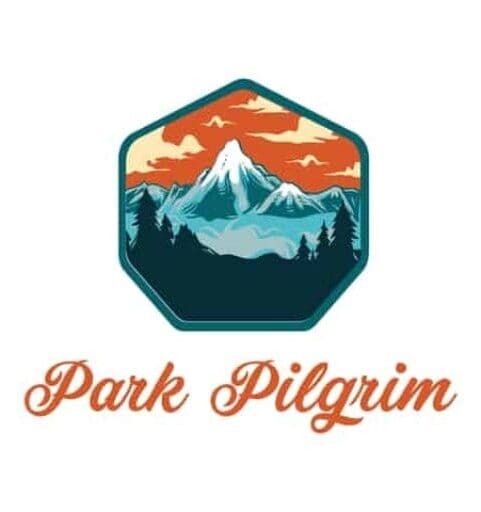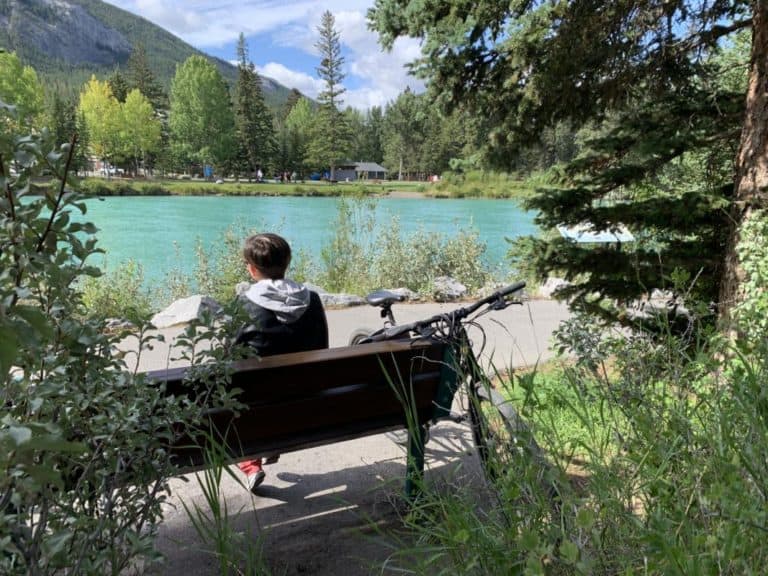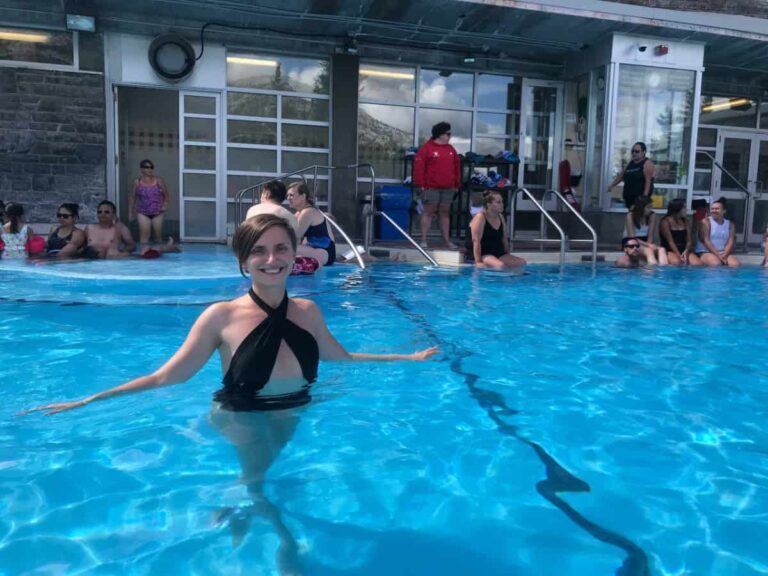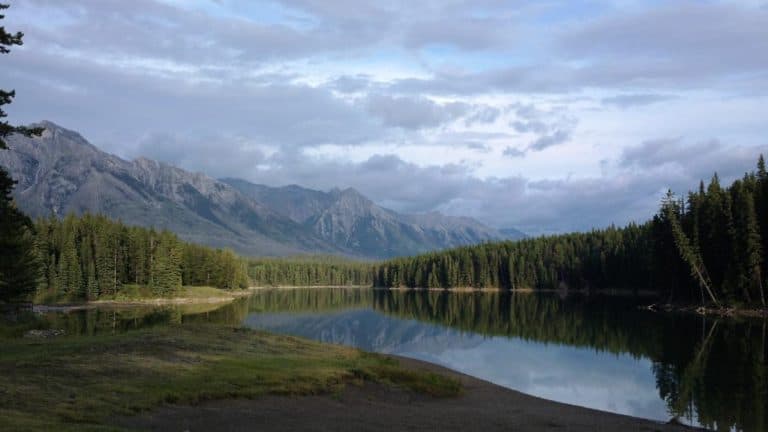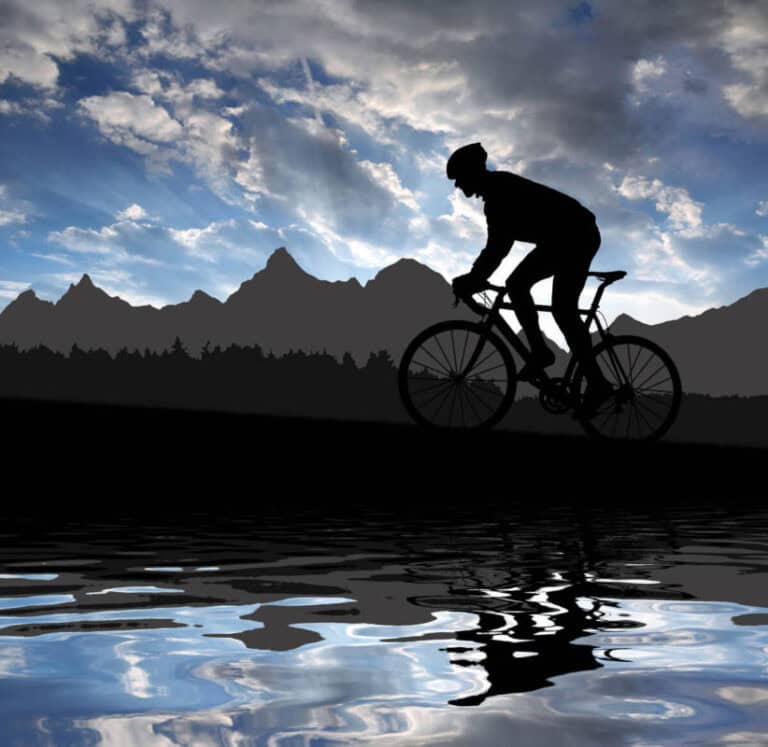Visiting Banff in January: Tips for a Winter Adventure
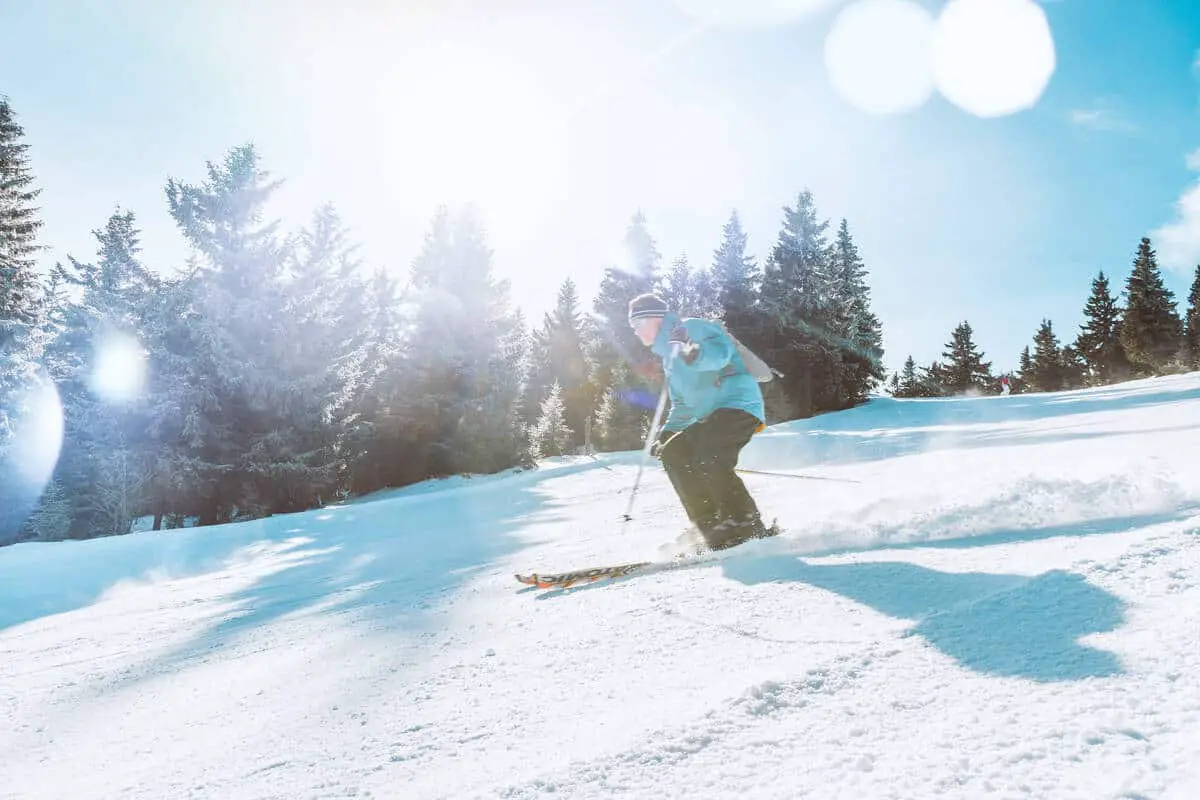
Banff in January is the perfect destination if you’re looking for a winter vacation. In January, the majority of visitors come to ski or snowboard. However, there are also a ton of other things to do this month that you might enjoy.
Talking about these other activities: January is perfect for ice skating, snowshoeing, dog sledding, and – if you’re daring enough – ice climbing, to name a few. If you’re lucky, you may even catch a glimpse of the Northern Lights.
Interested in visiting the park in January? Below you’ll find everything you should know. Let’s dive in.
Is Banff Worth Visiting in January?
If you don’t mind the cold, January is one of the best times to visit Banff due to the stunning winter scenery.
It is Banff’s second snowiest month of the year, making it an excellent time for winter activities like skiing, snowboarding, ice skating, snowshoeing and (dog)sledding.
Also, there can be unexpected warm days due to the Chinook winds.
However, all months have their specific pros and cons. I listed them below to give you a balanced perspective on visiting Banff in December.
The Pros and Cons of Visiting Banff in January
| PROS | CONS |
|---|---|
| 1. Winter sports: January is a great time to enjoy winter sports in Banff National Park. You can go skiing, snowboarding, snowshoeing, and ice skating, among other activities. | 1. Cold weather: January is one of the coldest months in Banff National Park, with temperatures often dropping well below freezing. You need to dress appropriately and be prepared for cold weather conditions. |
| 2. Snowfall: January is one of the snowiest months in Banff National Park, which means you can enjoy a stunning winter landscape with plenty of fresh snow. | 2. Shorter days: In January, the days are shorter in Banff National Park, with less daylight than during the summer months. You need to plan your activities accordingly and be prepared for early sunsets. |
| 3. Northern Lights: January is a great time to see the Northern Lights in Banff National Park. You can take a guided tour to see this natural phenomenon in all its glory. | 3. Limited access: Some roads and trails in Banff National Park may be closed or inaccessible during the winter months due to snow and ice. You need to check road and trail conditions before going out for your activities. |
| 4. Festive atmosphere: Banff National Park is known for its festive atmosphere during the holiday season. You can enjoy markets, light displays, and other holiday-themed events. | 4. Snowstorms: Banff National Park is known for its heavy snowfall during the winter months, which can lead to snowstorms and road closures. You need to be prepared for potential travel disruptions. |
| 5. Fewer crowds: January is a relatively quiet time in Banff National Park, with fewer crowds than during the peak summer season. This means you can enjoy the park’s beauty without feeling overcrowded. | 5. Limited transportation options: Public transportation options in Banff National Park may be limited during the off-season, which means you may need to rent a car or rely on private transportation. |
| 6. Cozy accommodations: January is the perfect time to cozy up in a warm and cozy cabin, chalet, or lodge in Banff National Park. You can enjoy the park’s beauty from the comfort of your cozy accommodation. | 6. Risk of avalanches: Banff National Park is known for its avalanche risk during the winter months. You need to be aware of the risk and take necessary precautions when participating in winter sports. |
| 7. Winter festivals: Banff National Park hosts winter festivals in January, such as the SnowDays Festival and the Ice Magic Festival. | 7. Limited wildlife viewing: Some animals in Banff National Park may hibernate or be less active during the winter months, which means you may have limited opportunities for wildlife viewing. |
| 8. Photography opportunities: January is a great time for photography in Banff National Park, with plenty of opportunities to capture stunning winter landscapes, wildlife, and the Northern Lights. | 8. Risk of road closures: With heavy snowfall and potential snowstorms, some roads in Banff National Park may be closed or have limited access during January. You need to check road conditions before going out and be prepared for potential travel disruptions. |
| 9. Hot springs: Banff is home to hot springs that are perfect for warming up on a cold winter day. You can relax and soak in the warm waters while enjoying the park’s stunning winter scenery. | 9. Risk of slippery conditions: With snow and ice covering the ground, you need to be aware of the risk of slippery conditions when walking on the street or participating in winter sports. |
Banff Weather in January
If you plan a trip to Banff in January, it’s important to know what weather to expect. Banff is a beautiful place to visit any time of year, but January is one of the coldest and snowiest months.
Average Temperature in Banff in January
The average temperature in Banff in January is around -10°C (14°F), but it can feel much colder with the wind chill. So you should dress in warm layers, including a good quality winter coat, gloves, scarf, and hat.
If you plan to spend a lot of time outside, wearing thermal underwear to keep you warm is a great idea.
Snowfall and Precipitation in Banff in January
January is one of the snowiest months in Banff, with an average snowfall of around 38 centimeters (15 inches). January rank as the second-snowiest month of the year after December (44 centimeters / 17 in).
However, it doesn’t snow every day, with a daily chance of snowfall between 7 – 11 percent.
On average, you can expect between 8 – 12 centimeters (3 – 5 in) of fresh snow per week, with about half the week seeing sunshine and clouds, and have the week snow.
The further away from the town of Banff and upwards from Lake Louise and the Icefields Parkway, the more snow you can expect.
Preparing for snow and ice on the roads is essential, especially if you plan to drive. Make sure your vehicle is equipped with snow tires or chains, and always check the road conditions before setting out on a journey.
Also check Your Go-To Guide to Winter Driving in Banff.
What Is a Chinook Wind?
When visiting Banff in January, you might experience a Chinook wind. This strong, warm, and dry wind can shift the temperature by 20°C (68°F) within a day.
While it can be a welcome relief from the cold, it can also cause rapid snow and ice melting, leading to flooding and other hazards. So be prepared for sudden changes in temperature and weather conditions if you’re visiting Banff in January.
Wanna know more about the climate in the Park? Check out the post that discusses everything about weather in Banff National Park.
What to Pack for a January Visit to Banff
Packing to visit Banff in January involves a bit more than visiting the park in summer. You need to bring suitable clothing to withstand the sometimes extreme weather.
Clothing
Packing to visit Banff in January involves a bit more than visiting the park in summer. You need to bring suitable clothing and dress in layers to withstand the sometimes extreme weather.
At the very least, bring the following items:
- Proper winter jacket
- Warm (ski) pants
- Sweater
- Thermal underwear
- Merino wool socks
- Winter boots
- Gloves
- Hat
- Scarf
Gear
Aside from warm clothing, you’ll also want to pack some gear. Here are some items you should consider bringing:
- Daypack to carry water, snacks, and extra layers
- Snowshoes or crampons for hiking in the snow
- Ski or snowboard equipment if you plan to hit the slopes
- Ice skates if you want to skate on frozen lakes
- Compass
- Goggles or sunglasses to protect against the glare of snow
- A camera to capture the stunning winter scenery
- Physical map (cell phone reception in the park is spotty)
Accessories
Don’t forget to pack some accessories to make your trip to Banff more comfortable. Here are some items worth considering for a trip to Banff in January:
- Refillable water bottle to stay hydrated
- Small first aid kit for emergencies
- Sunblock and UV-blocking lip balm to protect your skin from the sun’s harmful rays
- Moisturizer to keep your skin from drying out in the cold weather
- Safety gear such as a compass, knife, and bear spray if you plan to hike
- Extra battery pack to charge your camera or phone
Driving to Banff in January

Driving to Banff in January can be challenging due to winter weather conditions. Here are some things to keep in mind when driving to Banff in January:
- Winter Tires: It is essential to have winter tires on your vehicle when driving to Banff in January. Winter tires provide better traction and handling in snowy and icy conditions. Ensure your winter tires are in good condition and adequately inflated before hitting the road. If you have a rental car, ask the rental company about it.
- Check Road Conditions: Before embarking on your journey, check the road conditions and weather forecast. Alberta 511 is an excellent resource for the province’s current road conditions and closures. You can also call 511 toll-free for road condition updates or keep up to date through their app.
- Drive Slowly and Carefully: Snow and ice can make roads slippery and reduce visibility. Drive slowly and carefully, and increase your following distance for more stopping time. Avoid sudden movements, such as hard braking or sharp turns, which can cause your vehicle to lose traction and spin out of control.
- Carry Chains: If you are driving in the mountains, carrying chains is essential when encountering heavy snow or icy conditions. Chains can provide extra traction and help you navigate steep inclines and declines. In Banff, driving with chains in the mountains is mandatory in certain areas. They are lawfully required when driving to the Icefields Parkway (Highway 93 North), Banff-Windermere Highway (Highway 93 South), and most other roadways, except for Highways 1 and 16.
- Fill Up Your Gas Tank: Make sure you have a full gas tank before heading out. Gas stations are scarce in the park, and you don’t want to run out of gas in the middle of nowhere when it’s freezing cold.
- Be Prepared: In addition to winter tires and chains, carrying a winter survival kit in your vehicle in an emergency is a good idea. Your kit should include blankets, warm clothing, food, water, a flashlight, and a first aid kit.
Things to Do in Banff in January
As mentioned in the introduction to this article, most people who visit Banff in January take to the slopes for skiing or snowboarding fun. But there are plenty of other activities to enjoy. Here’s an overview of activities in Banff in January.
Skiing and Snowboarding in Banff in January
Banff National Park has three world-class ski resorts: Sunshine Village Ski Resort, Lake Louise Ski Resort, and Mt. Norquay Ski Resort. The ski resorts offer everything from beginner to advanced terrain, so there’s something for everyone.
Want to read more about skiing and snowboarding in the park? Read my Banff Ski Resorts Comparison!
Enjoy Après Ski in Banff in January
After a day on the slopes, head to one of Banff’s many après ski spots to relax and enjoy Banff’s energetic nightlife. Banff has plenty of bars, restaurants, and pubs. Some popular spots include the Banff Ave Brewing Co., Park Distillery, and the Rose and Crown.
Ice Skating in Banf in January
Ice skating is a classic winter activity, and Banff has several outdoor rinks. A popular rink is the Banff Skating Rink near the Banff train station. The rink is open daily from 10 am to 9 pm, and skate rentals are available on-site.
If you’re lucky – in case there’s not too much snow on the ice – you can also skate on one of the many lakes in the park, like Two Jack Lake, Jonson Lake, Cascade Ponds, Lake Minnewanka and the famous Lake Louise.
Go Skating at Lake Louise
Lake Louise, surrounded by the Rockies, is a stunning location for ice skating in January. The lake offers a large surface area and skate rentals are available at the Château Lake Louise. Part of the lake is prepared as a hockey rink.
Hiking, Snowshoeing, and Cross-Country Skiing in Banff in January

Consider hiking, snowshoeing, or cross-country skiing if you’re looking for a more low-key winter activity. Banff National Park has over 1,600 kilometers (994 mi) of trails, with options for all skill levels.
Some popular trails include the Johnston Canyon Ice Walk, the Lake Agnes Tea House Hike, and the Spray River Loop.
Hike the Tunnel Mountain Trail
A great hiking option in January is the Tunnel Mountain Trail. This quick hike is easily accessible from the townsite and offers breathtaking views of Banff and its surroundings. The trail ascends Tunnel Mountain through the forest and is about 4.3 km (2.7 miles) roundtrip.
Just be sure to dress warmly and wear appropriate footwear with good traction for walking on snow and ice.
Sledding in Banff in January
Sledding is a fun activity for all ages, and Banff has several great sledding hills to choose from. Just take your toboggan, choose a hill that’s steep enough for your desires, and off you go!
Want to know more about sledding in the park? Read my blog post dedicated to this fun winter activity.
Dog Sledding in January
For a truly unique experience, try dog sledding in Banff. Discover Banff Tours offers dog sledding adventures at Lake Louise and in Canmore. This is an absolutely extraordinary way to experience the winter landscape.
Want to know more about sledding in Banff? Check out Dog Sledding in Banff, the Ultimate Rockies Winter Experience.
Ice Walking and Ice Climbing in Banff in January
Banff offers ice climbing and ice walking tours for the more adventurous type. Ice climbing is a thrilling activity that involves scaling frozen waterfalls and cliffs.
In contrast, ice walking is a more relaxed activity on frozen lakes. Some popular companies that offer ice climbing and ice walking tours include Yamnuska Mountain Adventures and Banff Tours.
Johnston Canyon Icewalk
A cool activity is the Johnston Canyon Icewalk. This guided hike takes you along a catwalk through Johnston Canyon, where you’ll see frozen waterfalls and stunning ice formations. The hike is about 5.4 kilometres (3.4 mi) roundtrip and is considered easy to moderate.
Visit the Hot Springs in Banff in January
After a day of outdoor activities, relax in Banff’s famous hot springs. The Banff Upper Hot Springs are just a few minutes from downtown Banff and offer stunning views of the Rockies. The outdoor pool is open daily from 10 am to 10 pm. Highly recommended!
Wanna know more about the soothing effect of hot springs? Check out my comprehensive post on hot springs in the Banff area.
Visit Banff’s Famous Lakes in January
While Banff National Park’s famous lakes are mainly summer attractions, you can still visit most of them in the winter, as they are still accessible at this time of the year.
Can You Visit Lake Louise in January?

Yes, you can definitely visit Lake Louise in January! January is a great time to visit Lake Louise, as the winter season is in full swing and the lake is frozen. During this month you can enjoy winter activities such as snowshoeing and ice skating at Lake Louise.
Can You Visit Moraine Lake in January?
Unfortunately, the road to Moraine Lake is closed during the winter due to heavy snowfall and avalanche risk. The road usually closes in mid-October and reopens in late May or early June, depending on weather conditions.
However, if you are an experienced adventurer with avalanche knowledge and snowshoes or skis, it may be possible to access Moraine Lake during the winter. Just be sure to check for any warnings before heading out.
Can You Visit Peyto Lake in January?
Yes, you can visit Peyto Lake in January, but accessing the lake may be more difficult due to winter road closures, depending on weather conditions. However, if the road is open, January is a great time to visit Peyto Lake, as the winter scenery is stunning.
Do a Helicopter Tour in Banff in January
If you want to see Banff from a different perspective, consider taking a helicopter tour. Helicopter tours offer breathtaking views of the Rockies and are a great way to see Banff’s stunning scenery from above.
A helicopter trip in January means a stunning white landscape that delivers an entirely different view of the park than in summer. It’s absolutely stunning!
Some popular helicopter tour companies include Alpine Helicopters and Rockies Heli Canada.
The main downside of booking a helicopter tour in January is that cancellations due to severe conditions occur much more often than in the summer.
Wanna read more about helicopter tours in the park? Check out the Ultimate Experience: Book a Helicopter Tour in Banff.
Catch the Northern Lights in Banff in January

If you’re lucky, you may catch a glimpse of the Northern Lights during your visit to Banff. The Northern Lights, also known as the Aurora Borealis, is a natural phenomenon that occurs when charged particles from the sun collide with the Earth’s atmosphere.
The best time to see the Northern Lights in Banff is from December to March, on clear nights away from city lights.
Want to know about aurora borealis in the park? Read the post about the northern lights in Banff National Park.
Wildlife Viewing in Banff in January
Visiting Banff in January offers a unique opportunity to witness the park’s wildlife. Despite winter’s cold, you can see animals like elk, deer, bighorn sheep, and moose.
The cold temperatures and snow-covered landscape make it easier to spot them.
Enjoy Scenic Views in Banff in January
The snow-covered landscape of Banff in January offers breathtaking scenic views. The mountains, lakes, rivers, and forests provide a serene and peaceful atmosphere.
During my time in Banff, I couldn’t figure out what I found more beautiful: the park in summer or in winter. Still ain’t got it figured out.
In any case, the scenic views are ideal for some stunning Insta-material!
Where to Stay in Banff in January
Banff has many lodging options as a major tourist destination in North America. Check out your possibilities below.
Ski Resorts in Banff in January
If you plan on hitting the slopes during your visit to Banff in January, staying at one of the ski resorts may be your best bet. There are three ski resorts in Banff. Each resort offers a range of accommodation options, from cozy lodges to luxurious hotels.
At Lake Louise, you can stay at the Fairmont Château Lake Louise, located close to the ski hills. This luxurious resort hotel offers extensive amenities, including a spa and several dining options.
Mt. Norquay also has a range of accommodation options, including the Juniper Hotel and Bistro, just a few minutes from the ski hill.
The hotel offers stunning views of the surrounding mountains and various amenities, including a hot tub and sauna.
Banff Sunshine is another popular ski resort in the area. The Sunshine Mountain Lodge is located at the base of the ski hill, offering the only ski-in/ski-out access in Banff National Park. The lodge also has several dining options and a range of other amenities, including a sauna and an outdoor hot tub.
Hotels and Lodges in Banff in January

Banff has plenty of options if you’re looking for a more traditional hotel or lodge experience. The Banff Springs Hotel is one of the most iconic hotels in the area, offering a range of luxurious amenities, including a spa, several bars and restaurants, and stunning views of the mountains.
The same goes for the Fairmont Château Lake Louise.
The Rimrock Resort Hotel is another popular option with amenities like a spa, indoor pool, and several restaurants. Like the Banff Springs Hotel, the Rimrock is just a few minutes from downtown Banff.
For a more rustic experience, the Storm Mountain Lodge is a great option. The lodge is located about an hour outside the town of Banff, but it offers a range of cozy cabins and lodges, as well as a restaurant that serves up delicious meals made with all Canadian ingredients.
Hostels and Campgrounds in Banff in January
If you’re traveling on a budget, several hostels and campgrounds in the Banff area offer affordable accommodation options. The Samesun Banff is one of the most popular hostels in the area, offering a range of dorm and private rooms and a communal kitchen and lounge area.
The Tunnel Mountain Campground is another popular option for budget travelers. The campground is just a few minutes from downtown Banff and offers campsites for tents and RVs.
Want to read about your options for winter camping in the park? Check the post Winter Camping in Banff.
Getting Around Banff in January
Car Rental in Banff in January
Without a doubt, the best way to get around Banff in January is by renting a car. This will give you the most flexibility in terms of where you can go and when you can go there.
However, driving in winter can be challenging (see above), especially if you are not used to it. Make sure to rent a car with winter tires.
Banff has several car rental companies, including Budget, Enterprise Rent-a-Car, Hertz, Alamo and Avis. Prices can vary, so I’d suggest you shop around and compare prices before making a reservation.
Public Transportation in Banff in January
If you don’t want to rent a car, several public transportation options are available in Banff. The Roam Transit system operates year-round and serves Banff, Canmore, and Lake Louise.
Several routes operate on a reduced schedule in January, so check the schedule before you go.
Another option is the Parks Canada shuttle service, which operates between Banff and the Lake Louise Ski Resort. Ski shuttles are free for anyone with a valid lift ticket.
This service is free in winter but can be crowded, so be prepared to wait in line.
Taxis in Banff in January
Taxis are a good option if you need to get somewhere quickly and don’t want to wait for public transportation. Banff has two taxi companies, Banff Taxi and Taxi Taxi.
Prices can vary depending on the distance you need to travel and the time of day, so ask for an estimate before you get in the cab. In any case, cabs are expensive in Canada. Just so you know.
Festivals and Events in Banff in January
January is a great time to visit Banff because of the many festivals and events during this month. There is simply always something to do!
Here are some of the most popular festivals and events that take place in Banff in January:
New Year’s Eve
New Year’s Eve is the first major holiday of the year, and Banff knows how to celebrate it! There are fun events at Central Park, food stalls and live music. The fireworks display at midnight is not to be missed.
Ice Magic Festival

Each January, Lake Louise is home to the Ice Magic Festival. In this world-class ice sculpting competition, you can see ice sculptures come to life from huge blocks of ice.
The sculptures are truly unique. If you’re visiting the lake for the festival, it’s good to know there are ice skating, dog sledding, and snowshoeing opportunities as well!
SnowDays Festival
The SnowDays Festival is another popular event in Banff in January. The streets of Banff’s downtown are transformed into large winter galleries with enormous snow sculptures all over.
You can feel the thrill of skijoring by excited onlookers lining the streets of Banff Avenue. Kids can play at the SnowDays Play Zone. If you ask me, this is an excellent event for families and children.
Summer Attractions Also Open in Banff in January
While Banff is known for its summer activities, some summer attractions are also accessible in January. Here’s an overview:
1. Banff Gondola
One of the most popular summer attractions that remains open year-round is the Banff Gondola.
The gondola takes you to the top of Sulphur Mountain, where you can enjoy stunning views of the surrounding mountains and valleys. You can also snowshoe or hike to the summit in the winter if you want a more adventurous experience.
2. Cave and Basin National Historic Site
The Cave and Basin National Historic Site is a popular attraction in the summer, but it is also open in January. This is where Banff National Park was born, and it is a great place to learn about the park’s history.
You can explore the cave and basin, take a guided tour, and learn about the geothermal features of the area.
3. Johnston Canyon
If you enjoy hiking, the Johnston Canyon trail is a must-see. The trail takes you through a canyon with frozen waterfalls and ice formations.
The trail is covered in snow and ice in winter, making it a unique and challenging hike. You can also take a guided canyon tour to learn about all the canyon’s ins and outs.
Statutory Holidays in Banff in January
It’s beneficial to be aware of the statutory holidays in January because many people flock to the park during these times of the year. As a result, hotel occupancy rates increase and it is more probable that restaurants will be fully booked.
The following statutory holidays are celebrated in Banff in January in 2023:
- New Year’s Day (1 January)
Visiting Banff in January FAQ
What’s the Best Time of the Year to Visit Banff?
Banff is a beautiful destination year-round, so the best time to visit really depends on your interests and what you want to do while you’re there.
If you’re interested in hiking and outdoor activities, then June through Mid-September are a great time to visit. The weather is warm and the days are long, so you’ll have plenty of time to explore the area’s trails and lakes.
If you’re interested in skiing and winter sports, then the winter months of December through March are the best time to visit. The snow is at its best during this time, and you’ll have three ski resorts in the area to choose from.
WEATHER IN BANFF, CANADA: AVERAGE TEMPERATURE

When Is the Shoulder Season in Banff?
The shoulder season in Banff is typically in the spring and fall months. During this time, the crowds are smaller and the prices are lower, making it a great time to visit if you’re looking for a more affordable and peaceful vacation.
The months of May and September are particularly good times to visit, as the weather is not too cold or even pleasant and there are plenty of outdoor activities to enjoy.
What Time Does it Get Dark in Banff in January?
In January, the days are short and the nights are long in Banff. The sun sets between 16. 45 PM (1 January) and 17.31 (31 January), so it gets dark quite early.
Can You Go to Banff in January?
Absolutely! Banff is a popular destination for winter sports enthusiasts, and January is a great time to visit if you’re interested in skiing, snowboarding, or other winter activities. Just be sure to pack warm clothing and be prepared for cold temperatures and snowy weather.
When Is the Skiing Season in Banff?
The skiing season in Banff typically runs from late November through early May, depending on the weather and snow conditions. The peak season for skiing is usually in January and February, when the snow is at its best and the ski resorts are busiest.
However, there are plenty of opportunities to ski and snowboard throughout the entire season, so you can plan your visit based on your schedule and preferences.
Banff Travel Guide
Where Is Banff National Park, Canada?
Banff National Park is in the southwest of the province of Alberta. It’s home to the towns of Banff and Lake Louise and borders the province of British Columbia in the west of Canada. You can easily access famous places like Lake Louise, Moraine Lake, Peyto Lake and the stunning Icefields Parkway from these locations.
Banff and Lake Louise are situated in the Rocky Mountains of Alberta, close to the boundary with British Columbia, as shown on the map of Banff National Park below.
Is Banff, Canada safe?
Generally speaking, yes. Like most areas, Banff has crime, but it’s still a safe travel place. But Banff has a lot of wildlife, including bears and cougars, so you should always carry bear spray and exercise caution when hiking in the mountains.
How Do I travel to Banff, Canada?
Want to fly to Banff? Calgary International Airport (Code: YYC) is the closest airport. It’s 130 kilometers (81 mi) to the east of Banff.
Several cities, including Toronto, Chicago, Seattle, and Dallas/Fort Worth, have direct flights into Calgary.
Pick up a rental vehicle at Calgary International Airport, or take a private transport service to your destination. The trip to the park takes about 1 hour and 40 minutes.
Viator has several good options. Click the link to check the options and latest rates.
Banff Car Rental
Want to rent a car during your stay in Banff National Park? Rent one at Calgary International Airport or in the city of Calgary. Yep, there are rental firms in Lake Louise and Banff, but as these are small towns, your rental options can be limited.
Avis is a reputable car rental company, which I’ve used many times. Book now with Avis.
Banff Travel Planning Guide
Do I need a visa for Banff?
Most likely not. Citizens of the US, most European countries, Australia and New Zealand don’t need a visa to enter Canada. Not sure? Click the link to see whether you need a visa or not. The typical length of stay in Canada for people with visa-exempt passports is 90 days.
Do I need travel insurance for Banff?
You bet. Feel confident while traveling with a plan from Travel Insurance Master, one of the top names in travel insurance, for just USD 10 on average per day.
What’s the best way to book my Banff accommodation?
If you plan to book a hotel, hostel or bed & breakfast, Booking.com is your best bet. It has the most hotels listed and often offers the best rates.
Do I need to rent a car in Banf?
Absolutely. While Banff is one of the few national parks in North America with a sizeable public transport network, I strongly advise renting a car if you want to make the most of your visit.
Will my phone work in Banff?
It depends. In the towns of Banff and Lake Louise, you should have good to excellent reception. However, in more remote areas, the signal is spotty. In many places, there will be no signal at all.
What’s the best site to buy Banff flights?
If you’re looking for cheap flights to Banff, I recommend Skyscanner. No surprises with suddenly increased rates (for taxes, seats or luggage) upon checkout. What you see is what you get.
If Visiting Banff in January Isn’t for You…
After reading this you might decide not to go to Banff in January after all. If so, check out the articles linked below about traveling to Banff during other months.
- Visiting Banff in January
- Visiting Banff in February
- Visiting Banff in March
- Visiting Banff in April
- Visiting Banff in May
- Visiting Banff in June
